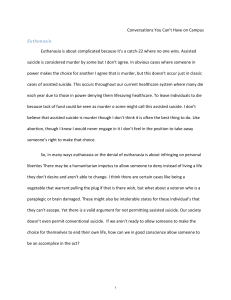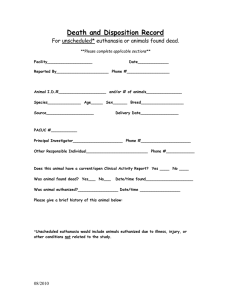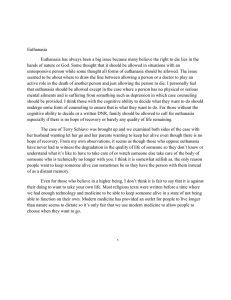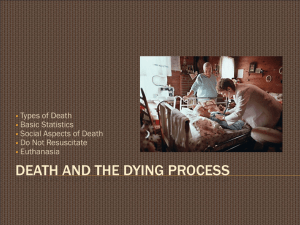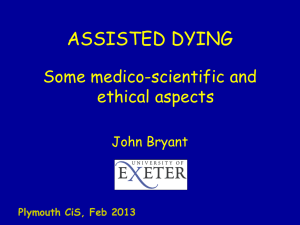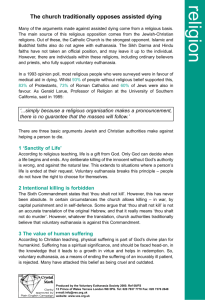Gabrielle Cuebas Dr. Koh ENG 101 December 3, 2008 Research Paper Final Draft
advertisement
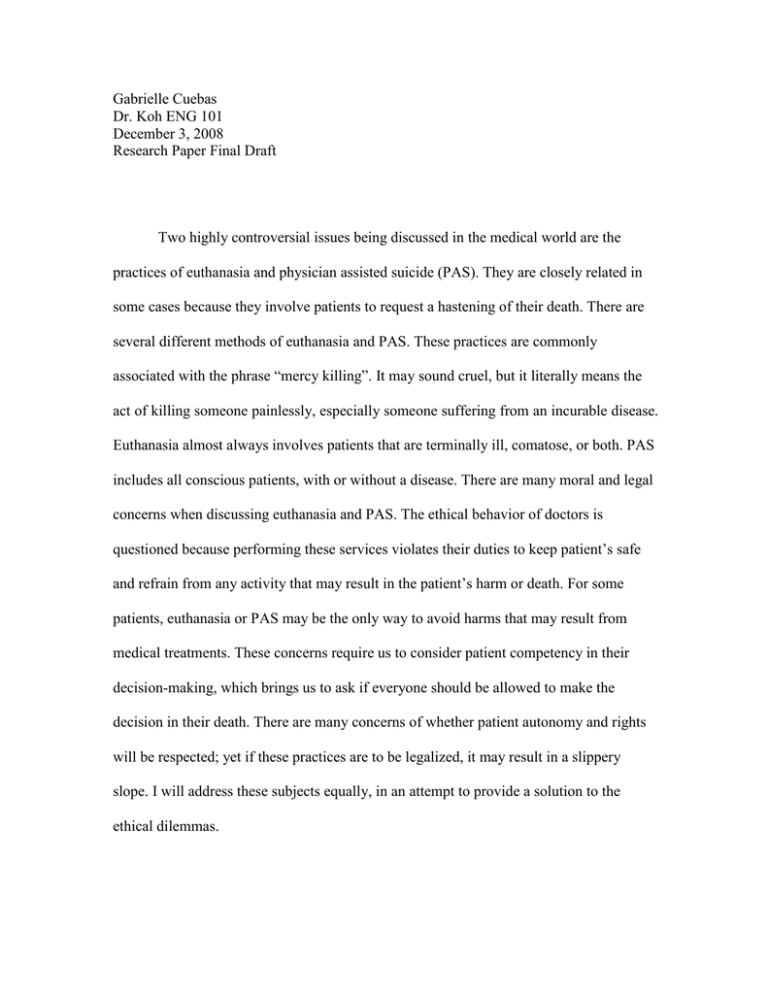
Gabrielle Cuebas Dr. Koh ENG 101 December 3, 2008 Research Paper Final Draft Two highly controversial issues being discussed in the medical world are the practices of euthanasia and physician assisted suicide (PAS). They are closely related in some cases because they involve patients to request a hastening of their death. There are several different methods of euthanasia and PAS. These practices are commonly associated with the phrase “mercy killing”. It may sound cruel, but it literally means the act of killing someone painlessly, especially someone suffering from an incurable disease. Euthanasia almost always involves patients that are terminally ill, comatose, or both. PAS includes all conscious patients, with or without a disease. There are many moral and legal concerns when discussing euthanasia and PAS. The ethical behavior of doctors is questioned because performing these services violates their duties to keep patient’s safe and refrain from any activity that may result in the patient’s harm or death. For some patients, euthanasia or PAS may be the only way to avoid harms that may result from medical treatments. These concerns require us to consider patient competency in their decision-making, which brings us to ask if everyone should be allowed to make the decision in their death. There are many concerns of whether patient autonomy and rights will be respected; yet if these practices are to be legalized, it may result in a slippery slope. I will address these subjects equally, in an attempt to provide a solution to the ethical dilemmas. There are two different kinds of euthanasia. Voluntary euthanasia is when terminally ill patients, who may be suffering through unbearable pain, request doctors to hasten their death. A doctor either administers a lethal dose of drugs for the patients to swallow, or provides a lethal injection. This is a method of active euthanasia, which can result in a doctor being convicted of some degree of murder and being sent to jail. After all, they are willingly participating in a patient’s death, which is illegal in most countries except for the Netherlands, “Belgium, and the American state of Oregon” (Boer, 529). A primary example of this is Dr. Jack Kevorkian, infamously known as Dr. Death. He participated in “more than 130 deaths in the 1990s,” either by euthanasia or assisted suicide, and was convicted of second-degree murder, which resulted in his spending eight years in jail (Davey, 12). Dr. Kevorkian did not feel he did anything wrong because he fulfilled his patients’ needs. Patients may also request a discontinuation of medical treatments that may be causing them pain. This may or may not result in the patient’s death anyway, depending on their condition. This is a form of passive euthanasia, because doctors are not taking a direct role in the patient’s death. The second form of euthanasia is non-voluntary. This poses a problem because a decision is made without the patients’ consent, likely because they are permanently comatose. In these cases, the patients’ family or physician must make the decision in death. Some tend to think this is a form of murder as well, because the patient has no say in the decision. Let us suppose that these assisted dying methods are legal, how can doctors avoid being convicted of crimes and remain accepted in society? This would be a very difficult task to undertake because it requires individuals and governments to reevaluate their moral values. Religious believers against assisted dying believe that the sanctity of life should remain sacred. When practicing these methods, innocent lives are being taken and many believe that “the intentional killing of an innocent human being is always wrong” (Boer, 530). I would disagree because, when practicing euthanasia and PAS, the true intention for most doctors is to relieve the pain and suffering of the patient, and, in a way, their families as well. The only way this behavior can be seen as unethical, for instance, is if the doctor disliked the patient, or wanted to discontinue care because of the time and money spent by the medical facility and staff. In legal terms, the only way that doctors can avoid conviction is if governments are willing to realize that these practices are not murder. As long as there are regulations to the use of these assisted dying methods, there should be nothing wrong with physicians fulfilling a patients wish to die. How can we allow people the right to make the decision in their death? Well, doctors must be aware of, and evaluate, the mental competency of the patient to make decisions for themselves. No one’s rights should ever be taken away, but they must be limited. For example, if a healthy patient decides they want to die because they are depressed, they should immediately seek help from a psychologist. Euthanasia or physician assisted suicide should not be available to everyone. These services should only be provided to those with a debilitating, life-threatening disease, because the goal of these practices is, and only should be, to relieve a patient from agony and suffering. Simply not wanting to live is not sufficient enough in allowing a person the right to die. If a healthy person does not feel that they are living meaningful lives, then they should desire to make different choices that can improve their lives, and not just take the easy way out of killing themselves. The circumstances are different in regards to terminally ill patients. Although some ill patients may become depressed, it is likely because of the pain caused by their sickness, and the fact that death is knocking on their door. While they should undoubtedly have the right to end their lives if the suffering becomes too great, they should also be better informed about the palliative services that many facilities provide to relieve their discomfort. Some places are inadequate in their services, so proponents of euthanasia “advocate improvement in palliative services” (Sanders and Chaloner, 42). There should be less emphasis on a “quick fix”, and more emphasis on the “quality and distribution of palliative care services” (Maley, 8; Sanders and Chaloner, 42). This is crucial in end-of-life decision making because, if I were an ill patient seeking medical attention, I would prefer to know that I can get help to live longer and suffer less, than just be offered to die hastily. It is very difficult to make a decision of when and how to die. While the evaluation of patient competency is necessary to allow these decisions, we must not forget the importance of respecting every patient’s individual rights and autonomy. In any case, it is understood by many that it is the “obligation of health professionals to respect patients’ informed choices”, assuming that patients understand the consequences of their decisions (Sanders and Chaloner, 42). People should have their autonomy respected, and “should be free to think, act, and makes decisions independently”, especially if they have the mental capacity to make difficult decisions (Sanders and Chaloner, 43). Respecting this freedom is as important as making people feel comfortable to express their desires without being criticized. Governments and societal norms make it difficult to make personal decisions because a lot of things are viewed as wrong, unethical, or sinful. Whatever choice someone wants to make, especially if it concerns their life, “should be the choice of the individual. Society [should not] dictate how people should end their lives” (Maley, 8). This is essential to autonomy. Just imagine that a patient is suffering from internal bleeding and cannot breath on his or her own. The pain may be so unbearable, yet everyone around them tells them that euthanasia or suicide is wrong because God, or another authority, said so. This patient will die a miserable death that could have surely been avoided, if they were given the freedom to make their own choice. In regards to permanently comatose patients, advocates of euthanasia agree that families should be allowed to decide to “withdraw life support” because “permanent unconsciousness [seems] incompatible with a meaningful existence” (Truog, 48). It is not necessary to keep people alive at all costs, especially if they are to never experience a conscious life again. There are ethical concerns that, if euthanasia and PAS are legalized, it will result in a slippery slope. People worry that societal pressures may result in unnecessary deaths. The chairman of the Direction Association for the Handicapped, Sam Lee Yuan-tai, believes that if euthanasia is legalized, “it might put pressure on the sick and handicapped to commit suicide as they might worry about becoming a burden to society and their families” (Yau, 6). This is a valid concern. But doctors should make it a point that these services should only be available to patients that are suffering. The important thing is that the staff of medical and hospice facilities should do whatever they can to reassure patients that any choices made in the patient’s death are of the patient’s decision. The views that practicing assisted dying is a form of murder can only be true if laws are violated. When doctor’s participate in these services, they should be acting upon a patients’ wish, not their own. The only way society will recognize that assisted dying is not murder is if governments around the world are willing to recognize that as well. Many people that oppose the practices of euthanasia and PAS come from strong religious backgrounds or Disability rights programs. While their concerns may be valid among themselves, religious views cannot be taken into account in medicine and science because of the massive controversy that results. This is crucial because many people do not have a religion or believe in God. The priority in practicing assisted dying services is the patient. Their autonomy and choices must be respected, as long as they have a legitimate reason in choosing to die. It is the responsibility of physician’s to provide all the moral support, palliative care, and reassurance, to all patients before, they suggest euthanasia or assisted suicide. There should be no encouragement, for people that are not suffering from lifethreatening diseases, to turn to euthanasia or suicide. It should be a last resort. The only way the world’s views will change about euthanasia, physician assisted suicide, and any other controversial issue, is when legal, political and theological views change. People need to be willing to realize that there may be an outstanding benefit over the harms that people may think will result. They have to remove their biases and exclude their emotions to recognize the reality. If we have the freedom to live our lives a certain way, we should be allowed to choose a certain death, provided it is a critically thought and rational decision.
